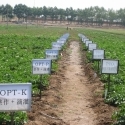09 Oct 2012
The importance of K in crop yield and nutrient use efficiency
 Rate, source and time of K application in Shandong
Rate, source and time of K application in Shandong
In the Northwest Region of China there are some soil tests that indicate higher available P, that is above the critical value of 12 mg/L as determined using the ASI Systematic Approach (Portch and Hunter, 2002). However, farmers usually apply more P than K in crop production, most probably because of an assumed lower availability of P in soils and a lack of demonstrated K deficiencies. It is our opinion that increased attention must be paid to nutrient management practices that focus on improving P use efficiency, and use of K in balance with P is one approach to addressing this. Below we have provided some examples that showed crop responses to potash in soils with higher available soil P levels.
In Inner Mongolia an experiment showed that application of K significantly increased the yield of sunflower (Table 1). It also improved partial factor productivity of P fertilizer (PFPP), and agronomic efficiency of P (AEP), a response that increased with increasing rates of applied K. Adding P in this study did increase crop yields (treatment 1 vs 4).
Table 1 Field experiment of P and K on sunflower in Inner Mongolia (2003)
| Treatment | Yield (kg/ha) | PFPN | PFPP | AEP |
| 1. N135P0K120 | 4578 c | 33.9 | - | - |
| 2. N135P90K0 | 4533 c | 33.6 | 50.4 | -0.5 |
| 3. N135P90K60 | 4889 bc | 36.2 | 54.3 | 3.5 |
| 4. N135P90K120 | 5178 ab | 38.4 | 57.5 | 6.7 |
| 5. N135P90K180 | 5500 a | 40.7 | 61.1 | 10.2 |
Yield LSD0.05 = 372 kg/ha
Partial Factor Productivity (PFP) (kg/kg) = crop yield per unit nutrient applied
Agronomic Efficiency (AE) (kg/kg) = crop yield increase per unit nutrient applied
In Qinghai another experiment with turnip showed that with the application of potash the PFPP increased, with the highest PFPP and turnip yield recorded when 90 kg K2O was applied (Table 2). Addition of K also improved the PFPN , with the 90 kg K2O application rate providing the best response.
Table 2 Effect of potash on yield of turnip in Qinghai (2004)
Treat. | Yield (kg/ha) | PFPN | PFPP |
| N75P103.5K0 | 56040 c | 747.2 | 541.4 |
| N75P103.5K45 | 61105 b | 814.7 | 590.4 |
| N75P103.5K90 | 74938 a | 999.2 | 724.0 |
| N75P103.5K135 | 71027 a | 947.0 | 686.3 |
| N75P103.5K180 | 64439 b | 859.2 | 622.6 |
LSD0.05 = 4976 kg/ha
In Xinjiang, the results from a trial with cotton demonstrated that when 207 kg/ha of N and 72 kg/ha of K2O were applied, the lint yield increased, but the PFPP decreased with increased use of P. When P was in the same rate of 138 kg/ha of P2O5 PFPP and AEP slightly increased with increasing rate of K applied up to a maximum with 72 kg/ha of K2O (Table 3). These experiments suggest that K was important in improving crop yield and nutrient use efficiency, a clear indication that it was out of balance with the N and P nutrients being applied to this cotton crop.
Table 3 Effect of P and K on lint yield of cotton in Xinjiang (2002)
Treat. | Yield (kg/ha) | PFPN | PFPP | AEP |
| N207P0K72 | 1331 e | 6.4 | - | - |
| N207P69K72 | 1478 b | 7.1 | 21.4 | - |
| N207P207K72 | 1539 a | 7.4 | 7.4 | - |
| N207P138K0 | 1393 d | 6.7 | 10.1 | 0.4 |
| N207P138K36 | 1459 bc | 7.0 | 10.6 | 0.9 |
| N207P138K72 | 1547 a | 7.5 | 11.2 | 1.6 |
| N207P138K108 | 1421 cd | 6.9 | 10.3 | 0.7 |
LSD0.05 = 44.8 kg/ha
These results clearly show the impact that a proper balance of macro-nutrients has on the uptake and efficiency of use for all nutrients being applied to a crop. The importance of this is obvious when we consider the recovery of nutrients by the crop grown, and the reduction of nutrients left in the soil and movement into the environment. Balancing the nutrients applied to crops will go a long way to improving crop production and nutrient use efficiency, but also in minimizing environmental impacts.
Reference:
Portch S. and Hunter, A. 2002. A Systematic Approach to Soil Fertility Evaluation and Improvement, Modern Agriculture and Fertilizers, China Program Spl. Publication No.5.




